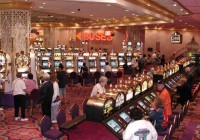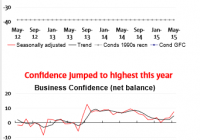There Is Potential To Be Found In The Market Vector Gaming ETF
Summary Revenue is a bit of an issue for casinos in the Macau region. This casino ETF has been hit hard and is currently floating around it’s 52 week low. Nevertheless, a high roller will always find it’s way back to the table and I’m not expecting this drop in share price to continue forever. The Market Vector Gaming ETF offers potential for many investors. Casinos; one loves them, the other hates them. It is a sector which is unquestionably linked to big spenders and unlucky losers. Unfortunately the Market Vectors Gaming ETF (NYSEARCA: BJK ) is currently not a money maker, as this ETF is dribbling near its 52-week low. This article will further discuss the main setup of BJK and the casino industry as a whole. (click to enlarge) Source : Wikipedia The Main Holdings This ETF’s main holdings are all accustomed players in the casino industry. (click to enlarge) Source : Van Eck The majority of these stocks either have exposure to Las Vegas and/or Macau as they are the 2 largest casino markets in the world. The Role of Macau Over the years, Macau, a former Portuguese colony and a city under the ‘ one country two systems ‘ policy by China, rose to become the Las Vegas of the East . It didn’t take long before it became the largest casino market in the world. As of today, more than 10% of Macau’s population is working in this specific market. Additionally, with Hong Kong only 37 miles away, Macau was positioned impeccably to grow out as a casino haven. And that is exactly what it did. (click to enlarge) Source : The Galaxy Macau Casino ETF – The Rise and Fall of Macau? The casino industry in Macau shares much resemblance of a typical rise and fall story : after the state casino monopoly ended in 2002, Las Vegas entered the market with American courage. It was big money, large risk and even bigger profits. For example, the current revenue of Macau’s casino industry is 7 fold of what is currently being brought into Las Vegas. And this is not simply because of more customers; it’s also due to large spenders. Unfortunately, casino revenues have fallen sharply in Macau by almost more than 50% year over year due to a variety of reasons. Reasons such as the slowing down economy in China and Chinese officials trying to track down potential corruption in the safe haven of Macau. In other words, the campaign of China against corruption and the pursuit of anti-gambling campaigns have caused the VIP’s not to hit the tables like they used to do in the past. A high wealth official would not want to be seen on tables in one of the Macau casinos, and with China’s politicians firing up the heat, who can blame them? Furthermore, with the Chinese government focusing more on discretionary spending and Macau’s casino landscape shifting to more family friendly related casino services, the percentage of revenue obtained from high rollers is currently diminishing. This was Macau’s strength in the past. Casino ETF – Many potential threats harming the casino industry All these factors such as tighter visa laws , more control on credit conditions, a potential smoking ban and restrictions on certain card payments is all harming profitability in one way or another. In my view, this will harm revenue’s for at least up to 2016. Additionally, in the pipeline there a number of new casinos which will open and this will spread volume and potentially diminish overall customers per casino. A typical case of wrong expectations between supply (of customers) and demand (the casinos). So considering the Casino market is going through some severe changes, how does the setup of this ETF look like? Market Vectors Gaming Fundamentals This ETF mostly tracks companies which generate more than half of their revenue from casino’s in one way or another. Net assets is somewhere around 30 million which is not incredibly large. (click to enlarge) Source : Van Eck With volume of around 20.000 a day, this ETF is not particularly liquid, but liquid enough for any small time investor to acquire a position and sell it relatively easily without having to suffer immensely in a bid-ask spread. Furthermore BJK paid a 2014 dividend of $1.88, giving the ETF a trailing 12-month yield of nearly 5%. Summary An investment in this ETF is a bet on the growing consumer wealth of China being spread out like butter on a piece of bread. Eventually the sheer volume of spending in the gambling industry will continue to grow; at least that’s my view for now. Will the super-rich return to Macau? My thoughts are that the investigation into further corruption is far from over, and as always, might take a while before a potential end is in sight. This will be a process which will last years, not months. Whether or not you pursue more tight regulation and control, high rollers will always find a way to invest their money in a different casino, whether that’s onsite or online makes no difference. Price Trend As share price has diminished significantly in the casino sector with the overall PE still declining from its highs at $35 to now averaging between $10-15, there is still room to fall. The short float is clearly rising (on anticipation…) even though the overall profitability is still substantial. Furthermore, debt remains an issue. So where does that leave us? Conclusion Macau might bleed, but the casino industry is far from over. Anywhere near $30 and this ETF become very interesting. As the super-rich become wealthier, they might cancel a trip to a casino, but they will find their way into any sort of casino, obviously picked up by any of the firms in this ETF. I’m not expecting casino stocks to drop to single digit values even though the graphs indicate significant drops over the last few months; they still bring in large substantial amounts of revenue. My expectation is that a potential short squeeze with positive news out of the casino market will propel this ETF (and many of its holdings) upwards. The main reason why my focus is on this ETF rather than the individual holdings is because I am sure not every firm will be as successful trying to fight its way through all the new regulations and tighter control. This ETF diminishes that risk. The potential is certainly out there. The numbers back the story. On an additional note For a more Macau related investment, one should look into Melco Crown Entertainment Limited (NASDAQ: MPEL ). They have recently invested in the Philippines , only a 2 hour flight from Macau and close enough for any high roller wanting to come from Hong Kong. This new strategy is very promising and I assume it will be very fruitful for Melco’s business. Disclosure: The author has no positions in any stocks mentioned, and no plans to initiate any positions within the next 72 hours. (More…) The author wrote this article themselves, and it expresses their own opinions. The author is not receiving compensation for it (other than from Seeking Alpha). The author has no business relationship with any company whose stock is mentioned in this article.

